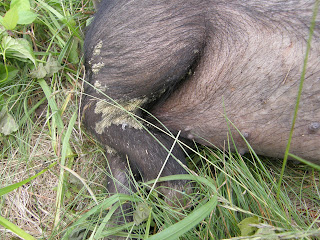Day 3: 18 June 2009
The pig carcasses from the urban site (CSU) have been moved to the rural site at University Farm. They were placed 50 meters apart and were enclosed with cages and a lean-to. Decomposition and insect activity will be monitored daily to investigate the presence of an invertebrate signature associated with the carcasses.
Blow flies have continued to lay eggs on the pigs, mostly on the soft tissues on the head or in the folds of skin on the body. These areas provide protection from the environment and also ensure that the eggs will remain moist.
Some eggs have matured into maggots and are feeding on the soft tissues. This seems to be more apparent in the rural site, especially for the pigs originally placed at the farm (Pigs 1 and 2). The moved carcasses (Pigs 5 and 6) show only a few egg masses which have yet to mature. In the city however, the ants have carried away many of the eggs from the body, leaving only a few maggots in the mouth of pig 3. Pig 4, the carcass with the abscess on its leg, has many ants covering the eyeball and in the mouth. Due to the ant activity, there are few eggs, none of which have matured into maggots.
Pig 1. Location: University Farm. More egg masses on the hind legs (Above). Eggs have matured into maggots and are consuming the eyes, mouth and nose of the pig (Below).
Pig 4. Location: CSU. Abscess on hind leg is bloated. Ants cover the eyeball and mouth, removing eggs laid by blow flies.
Pig 6. Location: University Farm, moved from CSU. Egg masses on cheek and in between eyes, but haven't matured into maggots. Ants are present on the face.
Submitted by Krystal Hans, MS student, Cleveland State University, 2 July 2009




No comments:
Post a Comment